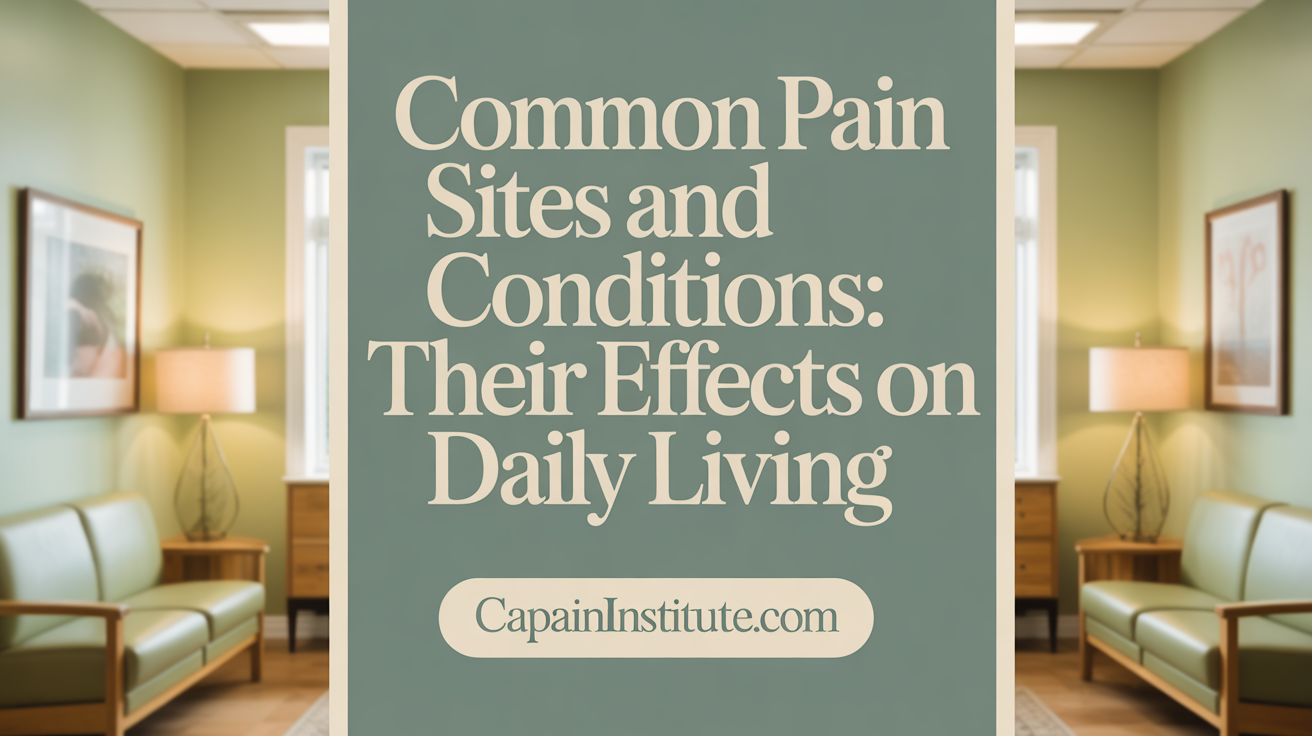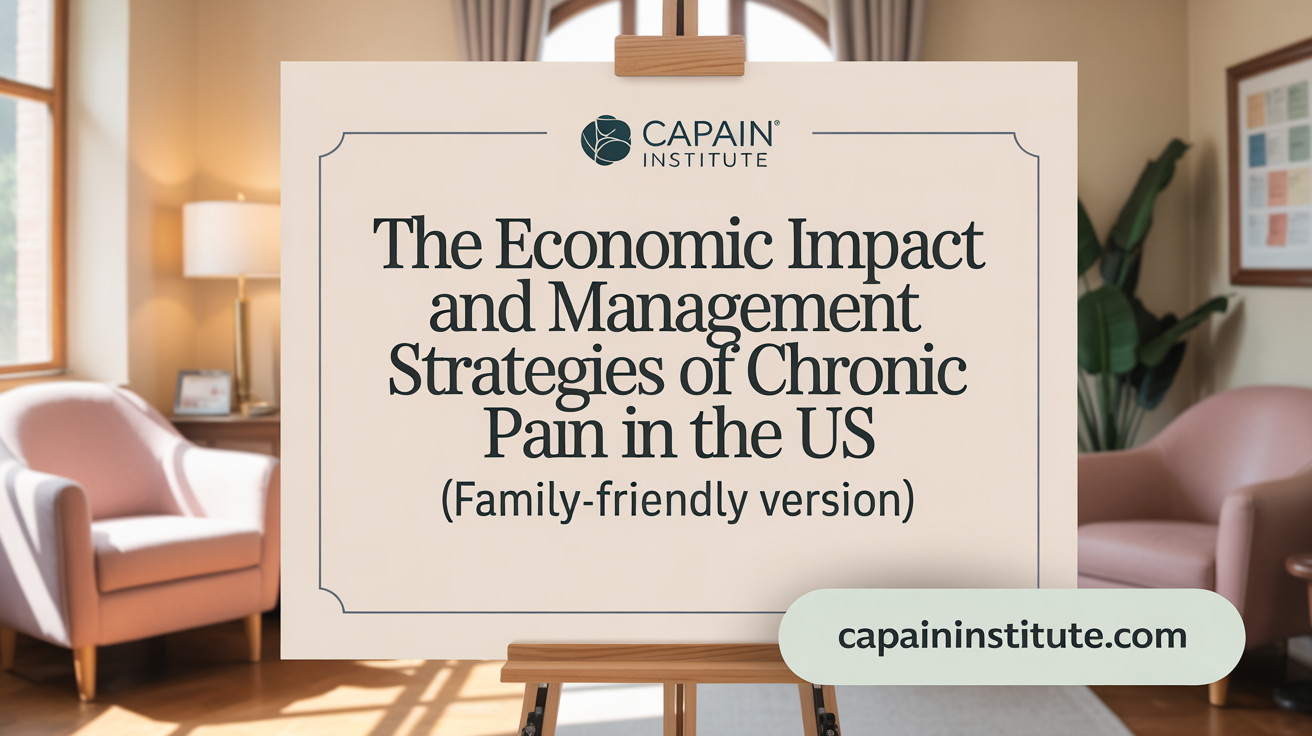The Prevalence and Significance of Chronic Pain in the U.S.
Chronic pain is a widespread and complex health issue affecting millions of adults across the United States. It imposes significant challenges not only on individuals' health and well-being but also on the broader healthcare system and economy. This article explores the prevalence of chronic pain and its high-impact form, examines demographic disparities, identifies common pain conditions and their effects on daily living, analyzes epidemiological trends, and discusses treatment patterns alongside the economic burden. Drawing on recent data from authoritative sources such as the CDC and leading scientific studies, we provide a comprehensive overview of chronic pain's current landscape in the U.S.
What Is Chronic Pain and Its High-Impact Form?

What is chronic pain?
Chronic pain is a long-lasting condition characterized by pain that continues for more than three to six months, often persisting beyond the normal healing period. It can be experienced as aching, stabbing, burning, or stiffness, and may be either constant or intermittent. Common causes include arthritis, back problems, nerve damage, cancer-related pain, fibromyalgia, and migraines. Sometimes, the exact cause of chronic pain remains unknown.
This type of pain significantly impacts people's lives, leading to physical, emotional, and mental health issues such as fatigue, depression, and anxiety. Managing chronic pain typically requires a multidisciplinary approach. Treatments may involve medications, physical therapy, psychological counseling, lifestyle modifications, and in some cases, surgical or alternative therapies. Despite best efforts, there is no definitive cure, making management an ongoing process.
What is high-impact chronic pain?
High-impact chronic pain (HICP) refers to a severe form of chronic pain that causes substantial limitations in daily activities, including work, social participation, and self-care. It is defined by pain that lasts on most days or every day over three months and interferes with life or work activities most or all of the time.
Individuals experiencing HICP often report poorer physical and mental health, with increased pain severity and greater healthcare use compared to those with less impactful chronic pain. Factors contributing to HICP include intense pain levels, psychological distress, and pain spreading across multiple body areas.
Recognizing high-impact chronic pain is crucial for providing targeted treatments aimed at improving function and overall quality of life, emphasizing the importance of comprehensive care strategies to address this significant health concern.
Prevalence, Demographics, and Disparities of Chronic Pain in the United States

What is the prevalence of chronic pain and high-impact chronic pain among adults in the United States?
In the U.S., chronic pain affects a significant portion of the adult population. Recent data shows that approximately 20.9% of adults, about 51.6 million people, experience chronic pain lasting more than three months. Within this group, around 8% suffer from high-impact chronic pain, which significantly limits daily activities—roughly 17.1 million adults. These figures reveal the widespread burden of chronic pain, which surpasses other common illnesses like diabetes and hypertension in terms of prevalence. Moreover, the numbers indicate that chronic pain is a persistent issue, with more than half of those affected still experiencing it after a year. The economic impact is substantial, with estimates of annual costs between $560 billion and $635 billion due to healthcare expenses and lost productivity. Chronic pain is also a leading cause of disability and healthcare access in the nation.
What are the demographic and age-related differences in chronic pain prevalence in the United States?
Demographic factors play a crucial role in chronic pain prevalence. Older adults, especially those over 65, report higher rates—about 28% experience chronic pain, with prevalence increasing with age. People aged 45-64 have a prevalence rate of roughly 27%, while younger adults aged 18-29 report lower rates, at approximately 12%. Women tend to experience slightly more chronic pain than men. Racial disparities are notable: American Indian and Alaska Native adults are twice as likely to report chronic pain compared to white adults. The prevalence also varies among racial groups, with lower reported rates among Black and Asian populations, though severity may differ. Socioeconomic status significantly influences pain prevalence. Adults with less than a high school education are almost three times more likely to suffer from chronic pain than those with higher education levels. Poverty is another factor, with individuals living below the federal poverty level reporting higher rates. Regionally, rural residents and those insured through public health programs report more pain than urban and privately insured counterparts. These differences highlight the importance of considering demographic and geographic factors in managing and addressing chronic pain.
What are the risk factors and demographic disparities associated with chronic pain in the United States?
Several risk factors contribute to the development of chronic pain. Age is a primary factor, with older populations being more vulnerable. Women generally report higher prevalence and severity of pain, a trend observed across various types of chronic pain. Socioeconomic disadvantages, such as lower income and education levels, are associated with increased pain prevalence and worse outcomes. Additional risk factors include existing health conditions like arthritis, depression, and obesity. Mental health conditions, specifically anxiety and depression, are strongly linked with chronic pain, with over 50% of those affected experiencing mental health issues. Disparities are evident across racial and socioeconomic lines. Although racial differences in pain reporting sometimes diminish after adjusting for social factors, certain groups like American Indian and Alaska Natives show higher risk levels. People with limited access to healthcare and lower socioeconomic resources tend to experience more severe pain and poorer health outcomes. These issues underline the necessity of targeted interventions that address social determinants of health and aim to reduce disparities in pain management.
| Aspect | Details | Additional Notes |
|---|---|---|
| Overall prevalence | About 20.9% (2021) | Approximately 51.6 million adults |
| High-impact pain | About 8% (2021) | Significantly restricts daily activities |
| Age | Most common among 65+ | 28% report chronic pain |
| Gender | Women > Men | Women report more severe pain |
| Race/Ethnicity | Native Americans > Whites | Lower reported rates among Blacks & Asians, severity varies |
| Socioeconomic | Lower education & income | Higher prevalence among lower socioeconomic groups |
| Regional disparities | Rural > Urban | Greater pain prevalence in rural areas |
Considering these data, addressing chronic pain requires a comprehensive approach that targets prevalent risk factors, reduces disparities, and improves treatment access for vulnerable populations.
Common Pain Locations, Conditions, and Their Impact on Daily Life

What are the common pain locations and conditions associated with chronic pain?
Chronic pain most frequently affects the back, joints, neck, and muscles. Among these, conditions like arthritis are prevalent, with nearly half of American adults experiencing some form of joint pain related to this disorder. Back pain is particularly common, experienced by approximately 28% of adults, and is often linked to degenerative changes, herniated discs, or spinal conditions.
Additionally, nerve-related pain or neuropathic pain occurs due to nerve damage, with estimates suggesting that 3% to 17% of Americans suffer from this type of discomfort. Migraines and tension headaches also fall under chronic pain categories, affecting a significant portion of the population.
Other commonly affected areas include the hips, knees, shoulders, and feet, depending on the specific underlying illness or injury. Fibromyalgia, characterized by widespread muscle tenderness, is another condition that contributes to chronic pain. The persistence of these pains typically extends beyond three months and can severely impair daily functions. Many individuals experience fatigue, emotional challenges, such as depression and anxiety, and struggles with sleep, highlighting the complex and overlapping nature of chronic pain conditions.
Overall, these pain locations and conditions are not isolated; they often coexist and lead to substantial disability and a significant decrease in quality of life.
What impact does chronic pain have on daily life and quality of life?
Chronic pain profoundly affects multiple facets of daily living. Physically, it limits mobility, reduces strength, and hampers the ability to perform daily activities such as self-care, household chores, and recreational pursuits. Sleep disturbances are common, with about 50% to 88% of sufferers experiencing ongoing sleep difficulties or insomnia.
Mentally and emotionally, the burden of persistent pain is substantial. It is associated with increased rates of depression, anxiety, and fatigue, which can create a vicious cycle that worsens overall health. Many individuals report feelings of helplessness and social withdrawal, which further diminish their overall well-being.
Social relationships often suffer as patients struggle with activity limitations and emotional distress. Their ability to work is also compromised, with many missing more workdays (average of 10.3 days) compared to those without chronic pain. This not only affects personal income but also has broader economic implications.
Effective pain management, involving a combination of medications, therapies, and psychological support, is crucial. Such approaches aim to reduce pain severity, improve functional capacity, and ultimately enhance life quality for those living with chronic pain.
| Location of Pain | Common Conditions | Impact on Daily Activities | Mental Health Associations |
|---|---|---|---|
| Back, neck, joints, muscles | Arthritis, spinal disc issues, fibromyalgia | Reduced mobility, sleep disturbances, activity limitations | Depression, anxiety, fatigue |
| Head, migraine | Migraines, tension headaches | Reduced productivity, social isolation | Helplessness, emotional distress |
| Feet, hips, knees, shoulders | Osteoarthritis, injury-related pain | Difficulty walking, standing, physical tasks | Emotional strain, potential depression |
This overview highlights how chronic pain's physical locations and underlying conditions intersect with their extensive effects on everyday life, emphasizing the importance of comprehensive treatment strategies.
Epidemiological Trends and Public Health Perspectives on Chronic Pain

What trends have been observed in the epidemiology of chronic pain in the United States over recent years?
Recent data reveals that chronic pain remains a prevalent issue in the U.S., affecting around 20% to 21% of adults each year. As of 2023, roughly 24.3% of adults report experiencing persistent pain within the past three months. The proportion suffering from high-impact chronic pain—conditions that significantly restrict daily activity—has also increased slightly, now estimated at about 8.5%.
Over recent years, the burden of chronic pain has grown among specific populations, including older adults, American Indian and Alaska Native groups, and residents of rural or lower socioeconomic areas. Disparities based on race, income, and insurance status remain prominent. However, trends indicate that the overall prevalence of chronic pain has been relatively stable or slightly rising, with detailed increases in pain related to joints, the back, and the neck since 2002.
Despite some public health efforts to address obesity, which is linked to chronic pain, the overall impact continues to challenge healthcare systems. The persistent rise in pain, combined with its effects on work ability and mental health, highlights the systemic nature of this condition. These patterns emphasize the ongoing need for effective pain management and preventative strategies to reduce the societal and economic burden of these conditions.
Chronic Pain Management and Economic Costs in the U.S.

What are the treatment patterns and health costs associated with chronic pain in the United States?
Chronic pain in the U.S. is managed through a combination of approaches, including medications, physical therapy, behavioral therapies, and complementary treatments like chiropractic care and massage. A significant portion of patients—around 90%—use opioids as part of their pain management, despite ongoing concerns about overuse and dependency.
Over the past two decades, opioid prescribing rates have risen sharply, often starting at specialized pain clinics. Healthcare use and costs are particularly high during the first six months of initiating opioid therapy. Patients on long-term opioids tend to have multiple health issues, such as arthritis, back pain, and psychiatric conditions like depression and anxiety, which increase their healthcare utilization.
This extensive level of care results in a considerable economic burden. The costs related to chronic pain are staggering, estimated between $560 billion and $635 billion annually. These expenses encompass direct medical costs, like hospital visits and medications, and indirect costs such as lost productivity due to disability or absenteeism.
Overall, managing chronic pain requires sustained healthcare resources, contributing heavily to the financial strain on the U.S. healthcare system. The widespread reliance on opioids and other therapies underscores the need for more effective and cost-efficient pain management strategies.
| Treatment Type | Percentage of Use | Cost Implications | Notes |
|---|---|---|---|
| Opioids | ~90% | High, especially early months | Long-term use raises concerns |
| Complementary therapies | ~35% | Moderate, growing evidence | Includes yoga, massage, chiropractic |
| Physical/Occupational therapy | Widely used | Variable, often outpatient | Common non-drug approach |
| Psychological therapies | Underutilized (~4%) | Potential high benefit | Underused despite mental health link |
This confluence of treatment patterns and associated costs highlights the pressing need for balanced, effective, and affordable strategies to improve chronic pain management across the U.S.
Addressing a Persistent Public Health Challenge
Chronic pain remains a pervasive and complex health issue affecting roughly one in five adults in the United States. It disproportionately impacts vulnerable groups including older adults, women, and those socioeconomically disadvantaged, while high-impact chronic pain exacerbates limitations on daily living and contributes to profound emotional and physical burdens. Despite its prevalence and costs, chronic pain management remains challenging, with heavy reliance on opioid therapies and significant economic implications for the healthcare system and society. Ongoing epidemiological monitoring, targeted preventive strategies, equitable access to multidisciplinary treatment options, and increased research investment are crucial to reduce this widespread public health challenge and improve quality of life for millions of Americans.
References
- Chronic Pain Among Adults — United States, 2019–2021 | MMWR
- Prevalence of chronic pain among adults in the United States
- NIH study finds high rates of persistent chronic pain among U.S. adults
- The Impact of Pain in America - U.S. Pain Foundation
- Estimated Rates of Incident and Persistent Chronic Pain Among US ...
- Chronic Pain Statistics in the United States
- High-Impact Chronic Pain
- 2024 Chronic Pain Fact Sheet - Sources - U.S. Pain Foundation
- Chronic Pain Prevalence Remains Among 1 in 5 US Adults - HCPLive
